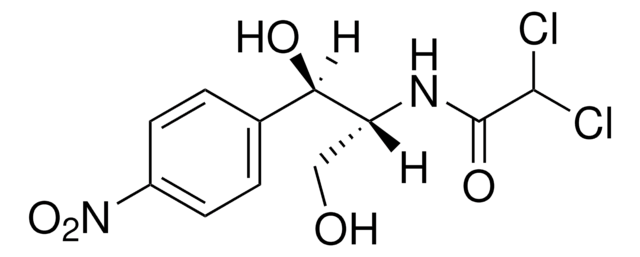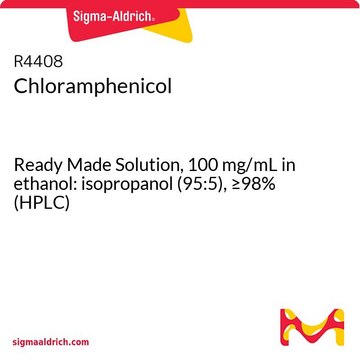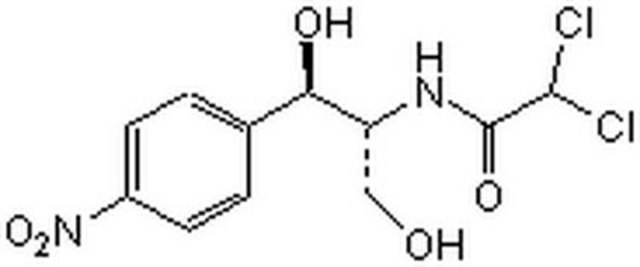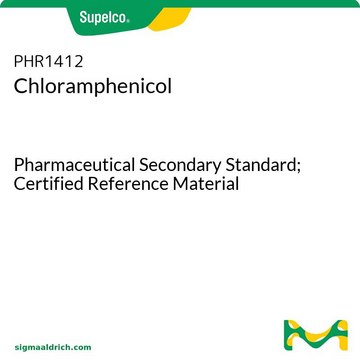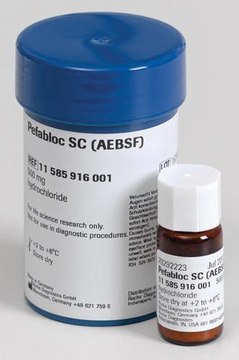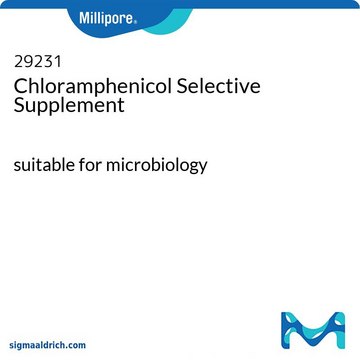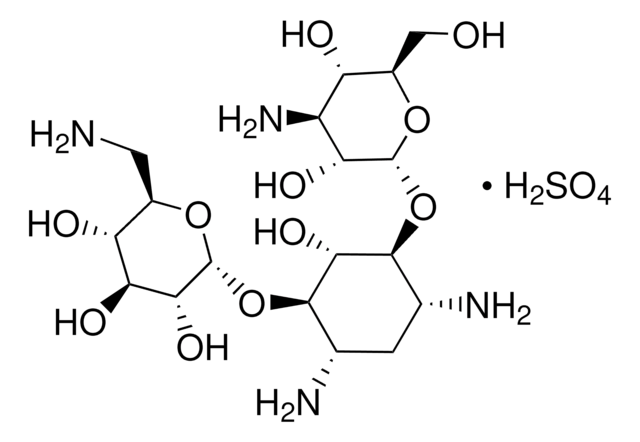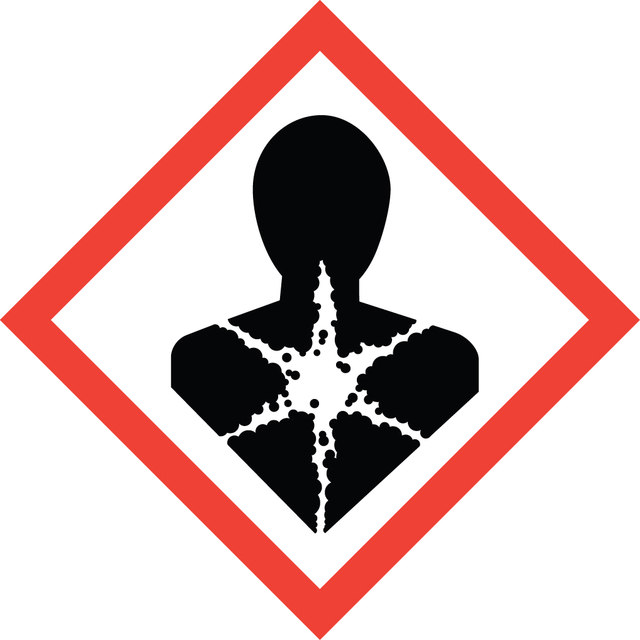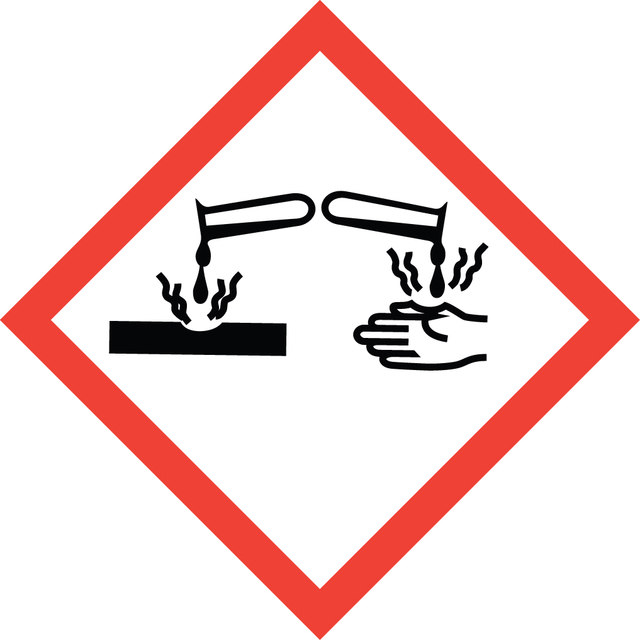C3175
Chloramphenicol-Water Soluble
powder, suitable for cell culture, BioReagent
别名:
Chloramphenicol, Chlornitromycin, Chlorocid, Chloromycetin, Cloramfenicol, D-(−)-threo-2-Dichloroacetamido-1-(4-nitrophenyl)-1,3-propanediol, D-(−)-threo-2,2-Dichloro-N-[β-hydroxy-α-(hydroxymethyl)-β-(4-nitrophenyl)ethyl]acetamide, Chloromycetin, D-threo-2,2-Dichloro-N-[β-hydroxy-α-(hydroxymethyl)-4-nitrophenethyl]aceta, Kloramfenikol
About This Item
推荐产品
产品名称
Chloramphenicol-Water Soluble, powder, BioReagent, suitable for cell culture
产品线
BioReagent
质量水平
表单
powder
技术
cell culture | mammalian: suitable
溶解性
H2O: 50-500 mg/mL (stock solution)
PBS: 50-500 mg/mL (stock solution)
other salt solutions: not recommended
抗生素抗菌谱
Gram-negative bacteria
Gram-positive bacteria
mycobacteria
mycoplasma
作用机制
protein synthesis | interferes
应用
- as a supplement in Luria-Bertani (LB) medium to culture Escherichia coli
- as a supplement in LB agar to culture Citrobacter rodentium
- to culture Toxoplasma gondii
生化/生理作用
包装
其他说明
警示用语:
Danger
危险声明
危险分类
Carc. 2 - Eye Dam. 1 - Repr. 2
储存分类代码
11 - Combustible Solids
WGK
WGK 3
闪点(°F)
Not applicable
闪点(°C)
Not applicable
个人防护装备
Eyeshields, Gloves, type P2 (EN 143) respirator cartridges
法规信息
历史批次信息供参考:
分析证书(COA)
Which document(s) contains shelf-life or expiration date information for a given product?
If available for a given product, the recommended re-test date or the expiration date can be found on the Certificate of Analysis.
How do I get lot-specific information or a Certificate of Analysis?
The lot specific COA document can be found by entering the lot number above under the "Documents" section.
How do I find price and availability?
There are several ways to find pricing and availability for our products. Once you log onto our website, you will find the price and availability displayed on the product detail page. You can contact any of our Customer Sales and Service offices to receive a quote. USA customers: 1-800-325-3010 or view local office numbers.
What is the Department of Transportation shipping information for this product?
Transportation information can be found in Section 14 of the product's (M)SDS.To access the shipping information for this material, use the link on the product detail page for the product.
How do I calculate the molarity of product C3175, Chloramphenicol-Water Soluble?
Product C3175 (Chloramphenicol-Water Soluble) is a complex of chloramphenicol and cyclodextrin. Cyclodextrin is used to aid in the solubility of chloramphenicol into water. In order to prepare a molar solution of chloramphenicol you will have to base it on the chloramphenicol content in the solution and not the entire complex. Product C3175 is formulated to contain approximately 100 mg chloramphenicol per gram of powder. Based on this average, if you are preparing a 500 mg/ml stock solution, there will be approximately 50 mg of chloramphenicol in 1 ml. Below is the calculated molarity of chloramphenicol when the complex is dissolved at 500 mg/ml in water. molecular weight X unknown molarity X volume = complex weight X complex ratio323.13 g/mol X Molarity X 1 ml = 500 mg X 0.1 Molarity = 0.155 Mchloramphenicol molecular weight = 323.13 g/molmolarity (unknown) = mol/Lvolume = 1mlcomplex weight = 500 mgcomplex ratio = 100 mg chloramphenicol/1 gm complex
My question is not addressed here, how can I contact Technical Service for assistance?
Ask a Scientist here.
商品
抗生素杀灭曲线是一项剂量响应实验,通过逐渐增大施加在哺乳动物细胞中的备选抗生素剂量进行测定。
Antibiotic kill curve is a dose response experiment in which mammalian cells are subjected to increasing amounts of selection antibiotic
我们的科学家团队拥有各种研究领域经验,包括生命科学、材料科学、化学合成、色谱、分析及许多其他领域.
联系技术服务部门